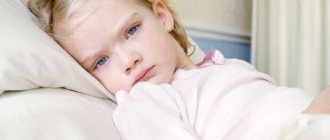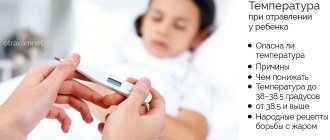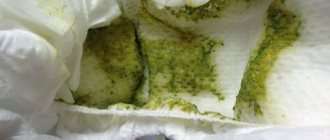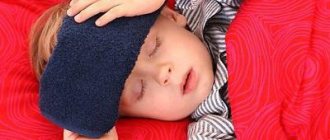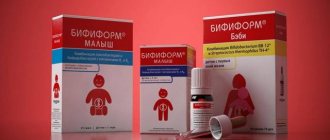Vomiting in a child after eating is an alarming symptom that frightens and worries parents. When studying the condition, physiological and pathological triggers are noted. If a gag reflex occurs, you must seek help from a doctor to eliminate the symptoms, treat the main provoking factor, and stabilize the water and electrolyte balance in the body.
Causes of vomiting in a child
The causes of nausea and vomiting after eating in a child can be quite different:
- Poisoning of the body with low-quality expired food products;
- Chemical poisoning;
- Long-term treatment with medications;
- Increased blood pressure;
- Stress;
- Nervous tension.
Under no circumstances should you self-treat gastrointestinal disorders in a child. You should definitely seek medical help from a pediatrician and get a referral for a number of laboratory and instrumental tests to analyze the gastrointestinal tract.
Diagnostic methods for determining the causes of gag reflexes after eating
First of all, the pediatrician asks parents about the circumstances surrounding the occurrence of vomiting:
- what the baby ate when he vomited;
- how many times he vomited;
- what the vomit looked like and whether it contained impurities;
- How often does a child vomit?
Based on the information received, the doctor can draw conclusions about the suspected illness. To make a diagnosis, the following examinations are prescribed:
- general blood analysis;
- esophagogastroduodenoscopy;
- X-ray with contrast.
During an endoscopy, an endoscopist examines the walls of the esophagus, stomach and duodenum by inserting a tube containing a fiber optic system into the patient. The image is transmitted to the computer monitor. During contrast fluoroscopy, a contrast agent is injected into the patient and then observed as it passes through the gastrointestinal tract.
If a pathology of the central nervous system or endocrine disorders is suspected, the pediatrician writes a referral to a neurologist or endocrinologist. These specialists may prescribe a biochemical blood test for hormones, an MRI or ultrasound of the brain.
What causes nausea in a child?
Depending on the color of the child’s vomit, the true cause of the pathology can be determined. For example, if vomiting occurs immediately after eating, and there is a large amount of bile, and the vomit is yellow or greenish in color, then this is food poisoning or a dangerous intestinal infection. As a rule, accompanying symptoms are fever, diarrhea, malaise, and pale skin. A child may have similar symptoms with inflammation of appendicitis.
If a child develops a feeling of nausea, and this repeats when he is given fatty or spicy food for lunch, then a corresponding reaction occurs. In this case, you need to completely change your diet. For example, include more fruits, vegetables, herbs and dairy products.
If a child vomits after almost every meal, this indicates the presence of some kind of pathology. In this case, you will not be able to independently determine the cause of vomiting.
So, the main causes of vomiting in a child can be:
- Inflammation of appendicitis;
- Food poisoning from expired products;
- Seasickness;
- Response to climate change;
- Disorders of the vestibular apparatus;
- Peptic ulcer of the intestines and stomach;
- Gallbladder pathologies;
- Inflammatory process in the pancreas;
- Stress, child distress;
- Overeating spicy and fatty foods;
- Gastroparesis;
- Indigestion.
Methods and means of treating vomiting
According to the recommendations of Dr. Komarovsky E.O. It is necessary to take first aid measures for the child (drink in small portions, do not feed during the acute period), call a doctor.
It is not permissible to independently treat vomiting for an unknown reason after eating; the risk of developing severe dehydration is high.
Principles of therapy:
- prescribing sorbent drugs in age-related doses (Enterosgel, Smecta, Atoxil, White Coal) to eliminate inflammatory processes, eliminate pathogens,
- the use of rehydrants to restore water and electrolyte balance (Regidron, Gidrosec, Oralit, Humana-electrolyte),
- therapy of the underlying disease: surgery for acute appendicitis and pyloric stenosis, treatment of acute respiratory infections, rehabilitation of chronic foci of infection, use of anthelmintic drugs in the presence of signs of parasitic infestation (Vormil, Pirantel), antihistamines to stabilize immune reactions, reduce symptoms of nausea (Loratadine, Alerzin, Fenistil).
The choice of treatment regimen for the child and diet is selected by the doctor individually, based on a diagnostic study.
If your child vomits blood
If we are talking about a teenage child, then the beginning of an unhealthy lifestyle, smoking and alcohol abuse, can lead to constant vomiting. This is the reaction of a young body to such toxic substances. Also, if a child does not eat properly - eats fatty, spicy foods, then most likely the gastrointestinal tract will “resist” and react very violently.
In some clinical cases, vomiting is caused by such serious pathological conditions as sarcoma and stomach ulcers. In this case, this condition may be accompanied by gastric bleeding. You need to be very careful with such conditions, as they can even lead to death. In such a degenerative pathological condition, streaks of scarlet blood in the vomit mean rupture of large vessels of the stomach and intestines. Don't hesitate! Be sure to call an ambulance, as the situation is very critical and only timely medical service can help.
If your child is vomiting black
If a child vomits black after eating, then the reason is a violation of the digestibility of food and long-term use of certain medications. It is possible that the reason is quite harmless and you previously gave the child activated charcoal and now his vomit has turned black.
Nausea can occur in a child if he was shouted at very strongly before and as a result, the baby began to vomit from increased nervous tension. Or the child’s psyche and the functioning of the central nervous system as a whole are disturbed - as a result, vomiting occurs. To prevent the next occurrence of vomiting, you need to calm the child down and give him water. If vomiting no longer occurs and relief has occurred, then make an appointment with your child for a consultation with a doctor.
Classification of causes, symptoms and treatment of biliary dyskinesia
Biliary dyskinesia is presented as a disorder of the biliary system. This pathology is characterized by a change in the tone of the gallbladder, which is expressed as a violation of the outflow of bile into the duodenum. Such changes in the body are accompanied by painful lumbago in the hypochondrium.
Gastritis? Ulcer? To prevent a stomach ulcer from turning into cancer, drink a glass...
The best FOLK remedy for GASTRITIS and stomach ulcers!
Classification of the disease
According to medical data, this disease is most often diagnosed in females. According to contractile activity, the disease is divided into:
- hyperkinetic;
- hypokinetic.
Hyperkinetic dyskinesia, or, as it is also called, spastic form, manifests itself in increased contractile activity and excessive excretion of bile. This form of the disease is mainly observed in the younger generation.
Hypokinetic biliary dyskinesia manifests itself in insufficient contractile activity and slow excretion of bile. The hypokinetic or atonic form of the pathology is observed in people over 45 years of age. The patient’s mental disorder is added to the clinical symptoms.
According to the nature of the course and source of development of the pathology, the disease is classified into 2 types. Primary GIVP occurs without changes in the gallbladder and ducts. If this pathological phenomenon is not treated in a timely manner, then after a short time bile stagnation will occur in the gallbladder. This can serve as a source of development of inflammation in the gallbladder and the formation of stones. All these phenomena have a detrimental effect on the body's digestive system.
Secondary dyskinesia is characterized by changes in the gallbladder and bile ducts. As a rule, this type of pathology develops as a result of certain diseases, for example, cholecystitis, constriction or kinking of the gallbladder.
Development factors
Biliary dyskinesia is one of the pathological diseases of the regulatory system. The main factor in pathological changes in the system is excessive consumption of salty, spicy, fried, fatty and smoked foods. The source of the development of the disease can be alcohol abuse or constant anger or irritability.
An equally common cause of dyskinesia is stressful situations that provoke spasms of the gallbladder and ducts, as a result of which bile is released into the duodenum. Penetrating into the pancreas, bile closes the passage and disrupts the release of pancreatic juice. The pancreas begins to destroy itself. In this case, there is a high probability of developing pancreatitis and diabetes. Dangerous complications of dyskinesia include the development of cholecystitis, duodenitis, atopic dermatitis and the formation of gallstones.
The causes of dyskinesia are quite varied. The main ones include genetic predisposition, viral hepatitis, neurosis, vegetative-vascular dystonia, dysbacteriosis, the presence of parasites, food allergies and endocrine diseases.
Dyskinesia of the gallbladder can occur with a hormonal disorder, for example, during pregnancy, with cirrhosis of the liver, premenstrual tension, and with systemic diseases.
In addition, the sources of development of the pathological process include poor nutrition, an inactive lifestyle and taking medications. Many medications can have side effects; after taking such drugs, bile accumulates in the gallbladder. All of the above reasons have a detrimental effect on the performance of the gastrointestinal tract, including the functioning of the gallbladder.
Symptoms
Signs of biliary dyskinesia: sharp or dull pain, sweating, vomiting and attacks of nausea after eating, constipation, fatigue and irritability.
The atonic form is characterized by dull and aching pain in the chest. The spastic form is characterized by sharp and cutting pain in the right hypochondrium, radiating to the shoulder blade or shoulder. As a rule, painful sensations are inconsistent and can be repeated several times during the day. The painful syndrome is not accompanied by high fever. Sometimes patients may complain of attacks of nausea or vomiting. These symptoms are especially worse after eating.
Throughout the day, the patient may experience headaches, excessive sweating and rapid heartbeat. Biliary dyskinesia may be accompanied by a sharp decrease in blood pressure and loss of strength.
Painful sensations worsen with a sharp increase in pressure inside the gallbladder. When overeating, the patient may complain of heaviness in the stomach, constipation and a bitter taste in the mouth. The pain syndrome appears as a result of stretching of the neck of the gallbladder, where a large amount of anticholecystokinin is produced. Thus, the functional activity of the gallbladder is significantly reduced and its tone weakens.
GDV is a complex disease of the gastrointestinal tract, which consists of alternating exacerbations and improvements. If treatment of the pathology is not started in a timely manner, an inflammatory process may begin in the gallbladder and its ducts.
Diagnostics
If biliary dyskinesia is suspected, the doctor examines the patient and performs palpation. As a rule, palpation is accompanied by pain in the right hypochondrium. In addition, the patient undergoes laboratory tests of blood, urine and feces. If an increased number of leukocytes is observed in the blood, this means that there is an inflammatory process in the body. Darker coloration of urine indicates the presence of bile pigments. Fecal analysis is carried out to identify parasites.
For a complete clinical picture, the patient undergoes an instrumental examination, which includes ultrasound of all organs and the gallbladder, duodenal intubation, FEGDS, oral and intravenous cholecystography and hepatobiliary scintigraphy.
When conducting diagnostics using ultrasound of the abdominal organs, the doctor determines the shape and size of the gallbladder, the presence of its constriction or inflection. Ultrasound of the gallbladder allows you to determine the form of pathological changes in the biliary tract.
The duodenal intubation procedure is not the most pleasant, but very effective. A special tube is inserted into the patient through the mouth, through which a small portion of bile is taken for examination. This analysis allows you to determine the symptoms of inflammation and the presence of stones.
If dyskinesia was caused by diseases of the esophagus or duodenum, then the patient undergoes FEGDS, which allows a detailed study of the condition of the abdominal organs. To perform oral or intravenous cholecystography, the patient drinks or is injected intravenously with a special contrast agent that envelops the gallbladder. In this way, the doctor determines pathology in the gallbladder and ducts.
Treatment
The doctor prescribes a comprehensive treatment for biliary dyskinesia. It consists of medications, physical therapy and diet. Mostly, for biliary dyskinesia, treatment is carried out at home.
Depending on the nature of the course and the severity of the symptoms, the doctor selects treatment on an individual basis. In the hyperkinetic form, the patient is prescribed cholespasmolytics and choleretic drugs. During the treatment process, doctors recommend drinking warm or hot mineral water, which reduces the tonic tension of the bile duct sphincters and restores the function of the gallbladder. Choleretic drugs help remove bile from the body.
When treating a pathological disease, thermal procedures are contraindicated. Doctors recommend taking cholekinetic drugs such as sorbitol, xylitol and magnesium sulfate. After taking such drugs, contractions of the gallbladder decrease and spasms disappear.
To normalize muscle tone in the spastic form of the pathological disease, the patient is prescribed cholespasmolytics. And with the atonic form, the patient takes enzyme preparations that facilitate the process of digesting food.
Among the physiotherapeutic methods of treatment, UHF, microwave, massage, inductothermy and electrophoresis have proven themselves well.
Electrophoresis is very effective for the treatment of dyskinesia. The principle of the procedure is the effect of electric current on the body. This procedure also involves the introduction of magnesium or potassium medicinal substances.
Hydropathic procedures show good results. The essence of the therapy is a circular warm shower. Diadynamic therapy helps to get rid of pain. In this case, the therapeutic effect is carried out by applying an electric current to the area of the right hypochondrium.
Local massage has a beneficial effect on the functioning of the gallbladder. Acupuncture has a similar therapeutic effect. Using the action of a needle on active points in the human body, the performance of the gallbladder improves.
Patients can have their duodenum washed with saline or mineral water. Surgical intervention in the treatment of dyskinesia is considered ineffective.
How to treat biliary dyskinesia at home? As a rule, treatment does not require hospital observation, so treatment of the disease can be carried out at home and, in addition to taking medications, treatment with folk remedies can be carried out.
You can prepare a decoction based on medicinal herbs: elecampane, chamomile and calendula. To do this you will need 10 g of elecampane roots, 2 tbsp. Chop chamomile and 15 g of calendula flowers thoroughly and pour 250 ml of boiling water. Bring to a boil and leave on low heat for 5-7 minutes. Take 50 ml decoction 20-30 minutes before meals.
The following recipe, which also uses medicinal herbs, will help you get rid of pain and bloating. Take 25 g of plantain leaves, 15 g of calendula flowers, chamomile, sage leaves, rose hips, cumin and 20 g of raspberries. Pour 2 tablespoons of the crushed mixture into 250 ml of boiling water and leave for 2-4 hours. Take 100 ml infusion before meals 30-40 minutes before meals.
Choleretic drugs can be replaced with a folk recipe. A mixture of carrot, spinach, parsley and celery juices promotes the removal of bile.
Shilajit can be used as a home treatment. Dissolve ¼ g of mumiyo in 250 ml of water. Take 100 ml 3 times a day. For a more effective result, treatment can be carried out in combination with taking beet juice.
Diet for biliary dyskinesia is considered one of the components of complex treatment. You should eat food 5-6 times a day. Portions should be small. The diet must include foods containing vegetable fats. Raw vegetables, herbs and bran have a positive effect on the motor processes of the bile ducts. You should avoid foods containing animal fats, eggs, mushrooms and meat.
Prevention of the development of the disease consists of maintaining a balanced diet. You should not eat foods that irritate the mucous membrane, such as sausages, canned food, pickled vegetables, salty foods, chips and sweet carbonated drinks.
Since the source of the development of the pathological process can be the nervous system, it is necessary to exclude stressful situations and promptly treat neurotic disorders. Adequate sleep, work and rest schedule, walks in the fresh air and preventive examinations will help avoid the development of the disease.
What to do if you have food poisoning?
What to do if your child has food poisoning? The first thing to do is to cleanse the stomach of any remaining undigested toxic food. To do this, you need to drink a large amount of warm water with the addition of 1 tbsp. salt and 1 tbsp. sugar per liter of water. You can drink plain water, but only in small portions every 15-20 minutes. In no case is it recommended to give medications or take any independent measures before the ambulance arrives.
If you know that your child’s nausea is chronic, then you need to give him warm green tea. This drink is very good at relieving vomiting.
A 2-3 year old child may vomit after eating due to impaired metabolism, an intestinal infection, or a viral disease. If a child has a fever, a feeling of nausea and vomiting, and very severe abdominal pain, especially in the lower right part of the abdomen, then be sure to call an ambulance. Most likely, appendicitis has become inflamed.
First aid for vomiting
Regardless of what factor triggered the vomiting, the child always needs help. Repeated triggering of the reflex is dangerous due to dehydration of the body, loss of salts and disruption of the baby’s condition, up to loss of consciousness and falling into a coma. Therefore, even a one-time episode of vomiting deserves the attention of parents.
If a child suffers from an increased gag reflex and vomits masses at every opportunity, during an attack the mother should do the following:
- calm the baby and change his clothes, help rinse his mouth and moisten his face with a napkin;
- allow the baby to take a comfortable position, and when trying to snatch again, turn his head to the side, not allowing the masses to clog the airways;
- in case of poisoning with poor-quality food, rinse the stomach by giving the child a glass of soda solution (0.5 tsp of soda per 1 liter of water). Next, you should press on the root of the tongue and artificially induce vomiting. In an unconscious state, children are not washed.
If attacks occur more than once every 3 hours, you need to call the ambulance service.
conclusions
When a child vomits without fever or diarrhea, it is important not to get confused and not to miss the formidable symptoms of serious diseases, in which it is necessary to take the baby to a medical facility as quickly as possible to provide professional assistance.
On the other hand, you need to be able to recognize a common eating disorder and, without panic and unnecessary transportation to a doctor, help at home.
In both cases, it is necessary to avoid taking antibiotics, and be sure to give the baby fluids to drink to avoid dehydration.
source: www.pupsek.com
When to call an ambulance
Only a specialist can make an accurate diagnosis, but in order not to waste precious time, it is necessary to urgently call an ambulance if the following symptoms appear:
- a rapid heartbeat appeared;
- sudden coldness of the hands and feet;
- nausea is accompanied by an unreasonable loss of strength, the baby is inactive, drowsy, has involuntary convulsions or has a fever;
- acute pain in the abdomen, diarrhea;
- due to frequent vomiting attacks, signs of dehydration began;
- Nervous excitability has increased, he behaves excessively restlessly, cries, screams;
- loses consciousness or is in a borderline state;
- there is a suspicion of food or drug poisoning;
- the skin became pale;
- I started vomiting after bruising my head area.
Vasilyeva E.S., Novocherkassk, Children's City Hospital, neonatologist
In case of nausea in infants, before the doctor arrives, it is necessary that the baby does not choke on vomit.
To do this, it is best to hold it vertically, turning the head slightly down and to the side.
What measures to take
What to do if a child feels sick and vomits without fever? When nausea occurs suddenly, a clear and consistent response is necessary.
- First of all, if the child feels sick and vomits, there is no fever, you need to give him cool, clean water with mint extract to drink in small sips . The older the baby, the colder the water may be.
- In order to prevent ingestion of vomit, the baby should be upright, with his face down .
- Within 15 minutes after nausea, to restore the acid-base balance, dilute one packet of Regidron in one liter of warm, filtered or boiled water. Give this solution in small sips of a quarter glass every half hour.
- Carefully monitor the condition: if after vomiting his health has not worsened during the day, and there are no other symptoms, and the baby drinks fluids normally and is playful, then you can calm down, but be sure to show him to the pediatrician the next day .
- If the child feels sick and vomits, there is no fever, it is also good to give him a warm rosehip decoction or weak tea.
- In addition to the drug Regidron, to relieve possible intoxication, they give half a tablet of activated carbon, or Smecta.
It will be better if there is a break between Regidron and Smecta when taking it
Reviews from parents
Daria, 25 years old, Rostov
When my two-year-old baby started feeling nauseous, I didn’t immediately realize that it was because he had swallowed a button. We only figured it out at the children's clinic.
I think in a state of panic it is always better to immediately seek help from a doctor.
Marina, 30 years old, Saratov
When my five-year-old baby gets sick and vomits, I always give him an activated charcoal tablet, just in case.
Susanna, 28 years old, Shakhty
Herbal teas - chamomile or mint - help relieve my son's nausea.
Combinations with other symptoms
Nausea and fever may indicate the presence of intestinal obstruction, indigestion, irritable bowel syndrome, or acute appendicitis. Nausea and headache indicate increased intracranial pressure, migraine, fatigue, stress, brain tumor, meningitis, borreliosis. Nausea and diarrhea indicate the presence of toxic substances in the child's body. This manifestation may be a consequence of overeating and consumption of heavy foods. It may also indicate the presence of cancer, stressful situations, allergies or intolerance to certain foods. Nausea and dizziness indicate labyrinitis, cervical osteochondrosis, vestibular neuritis, Meniere's disease, head injuries, and pathology of the eye muscles. May be a consequence of taking medications or stressful situations. Bile nausea indicates liver disease, bile reflex, gallbladder or bile duct disease. Nausea with bile indicates an acute form of pancreatitis, cyclic vomiting syndrome, and small intestinal obstruction.
Adviсe
It is important to ventilate the room if the child is vomiting or feeling sick.
- If your baby starts vomiting, do not rush to give him something to drink. It is advisable to wait a pause of at least 30 minutes. After this, it is recommended to offer the child literally a few sips, but only plain water. If you have it on hand or you have the opportunity to go to the pharmacy, you can prepare a saline solution, for example, Regidron, and use it to feed the baby. If the vomiting is a one-time occurrence, then you can try giving the little one a drink every quarter of an hour.
- After vomiting, try to rinse your toddler’s mouth to get rid of any vomit residue.
- It is not recommended to eat for four hours after an attack of vomiting.
- It is important that the child does not lie face up; it is better that he lies on his side.
- Ventilate the room. After all, it is important for the baby to get fresh air. In addition, the aroma from vomit can provoke a repeat attack.
- If vomiting is not one-time, but is repeated many times, then you should definitely call a doctor. If, in addition to it, diarrhea is present, hurry to call an ambulance.
How is the treatment carried out?
In serious cases, for example, with gastrointestinal diseases or other surgical pathologies, the child is hospitalized for treatment in a hospital. In other cases, home treatment is prescribed, which consists of following a diet and nutrition regimen, as well as properly replenishing the volume of lost fluid.
Children are little people whose bodies are not yet adapted to all the peculiarities and oddities of this world. The task of parents is to raise a healthy child prepared for adulthood, monitor the well-being of their child and always come to his aid. If a child vomits after eating, do not panic, but rather consult a doctor who will determine the problem and prescribe treatment.
- cardiospasm;
- neurosis;
- failure: vascular or cardiac.
No fever or diarrhea
In diseases of the nervous system, after experiencing a psycho-emotional breakdown, severe shock, or a sharp jump in arterial or intracranial pressure in a small child, doctors do not deny functional vomiting. In infants, everything is often limited to copious regurgitation, especially after feeding, since the digestive tract is not yet perfect. In older children, the cause of such a functional reaction is an unstable psyche - neurotic vomiting can occur in response to:
- punishment;
- compulsion;
- quarrel.
Separately, doctors distinguish psychogenic vomiting, which occurs during force feeding when the child refuses food. There are no health problems. All these cases are not symptoms of serious pathologies and they mostly disappear on their own as the nervous system develops, but they can also be observed in a teenager. Treatment in such a situation should be aimed at normalizing the psycho-emotional background, often requiring a visit to a psychologist.
The child is vomiting and has a stomach ache, no fever
If the attack is continuous, it may be associated with helminthic infestation or be a sign of appendicitis (pain will appear to the right of the navel). Particularly severe causes of vomiting in children without fever, but with abdominal pain:
- exacerbation of ulcers;
- erosive gastritis;
- polyposis
Preventive actions
To prevent nausea, you must:
Avoid eating expired, low-quality food; It is necessary to do heat treatment of kitchen equipment; Medicines should be taken strictly according to the instructions; When experiencing motion sickness in transport, it is recommended to take appropriate medications. For example, Relanium, Medazipam, Prazepam; It is recommended to stay in smoky rooms as little as possible; You should walk more often and be in the fresh air, do exercises; You need to sleep at least eight hours a day; You should make a proper diet. When feeding newborns, dishes must be subjected to heat treatment;
Nausea is an unpleasant symptom that occurs due to various situations. If a child is sick, then first of all it is necessary to identify the cause of the illness. If the baby’s condition worsens, you should contact a professional specialist. In simple cases, you can use folk recipes.
It must be remembered that preventing nausea is easier than treating it.
Among women
Sick in the morning and not pregnant. Let's figure it out. What, besides the “interesting situation,” are the causes of vomiting in the morning in women? There may be several of them:
- gastrointestinal diseases;
- postoperative period;
- chemical and food poisoning;
- liver diseases;
- disruptions in the functioning of the central nervous system;
- the presence of foci of inflammation in the kidneys and urinary tract;
- gallbladder diseases;
- disruptions in the functioning of the cardiovascular system.
Among the causes of morning sickness in women is the onset of their menstrual cycle.

